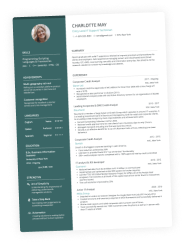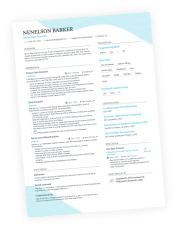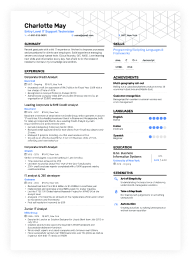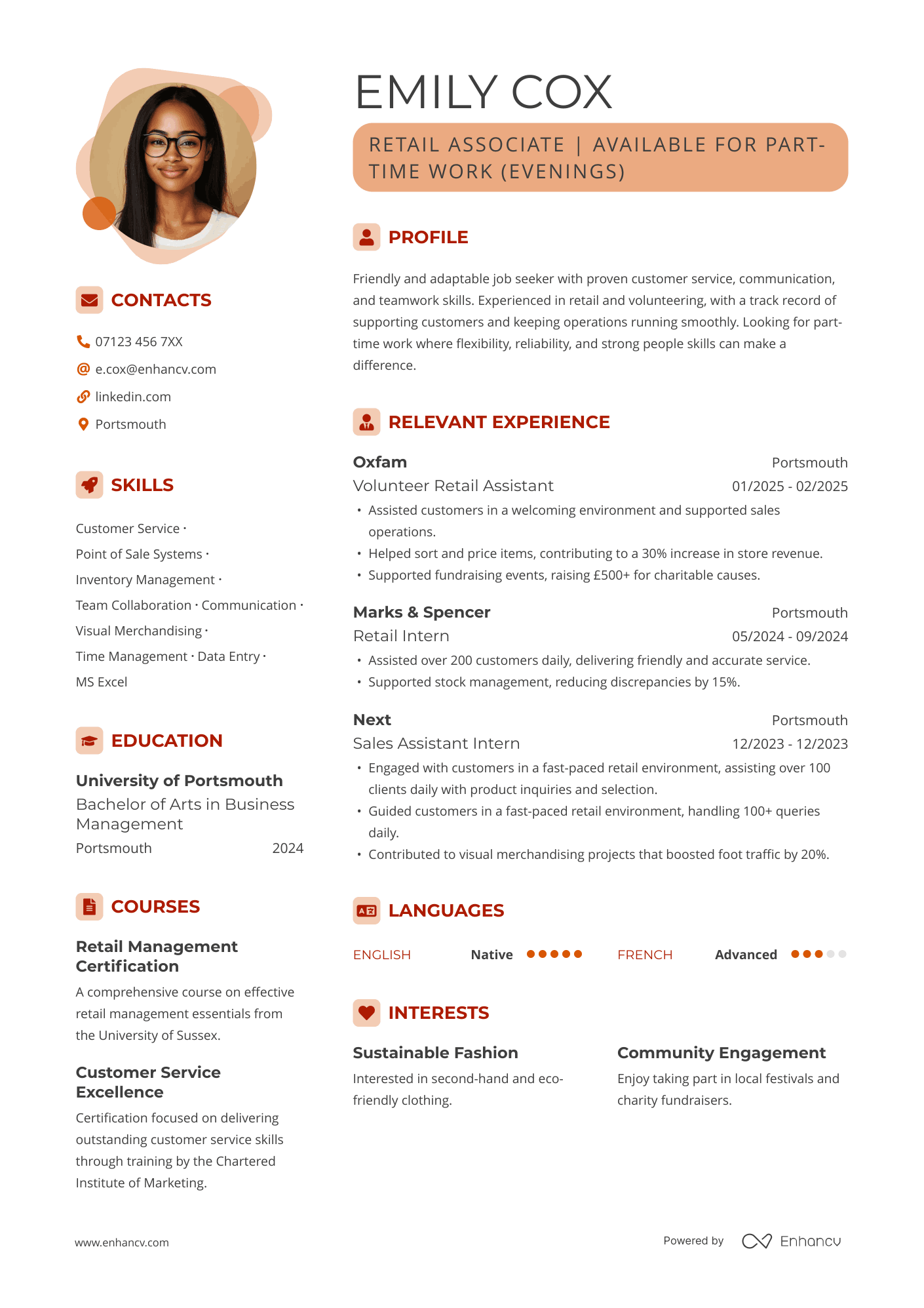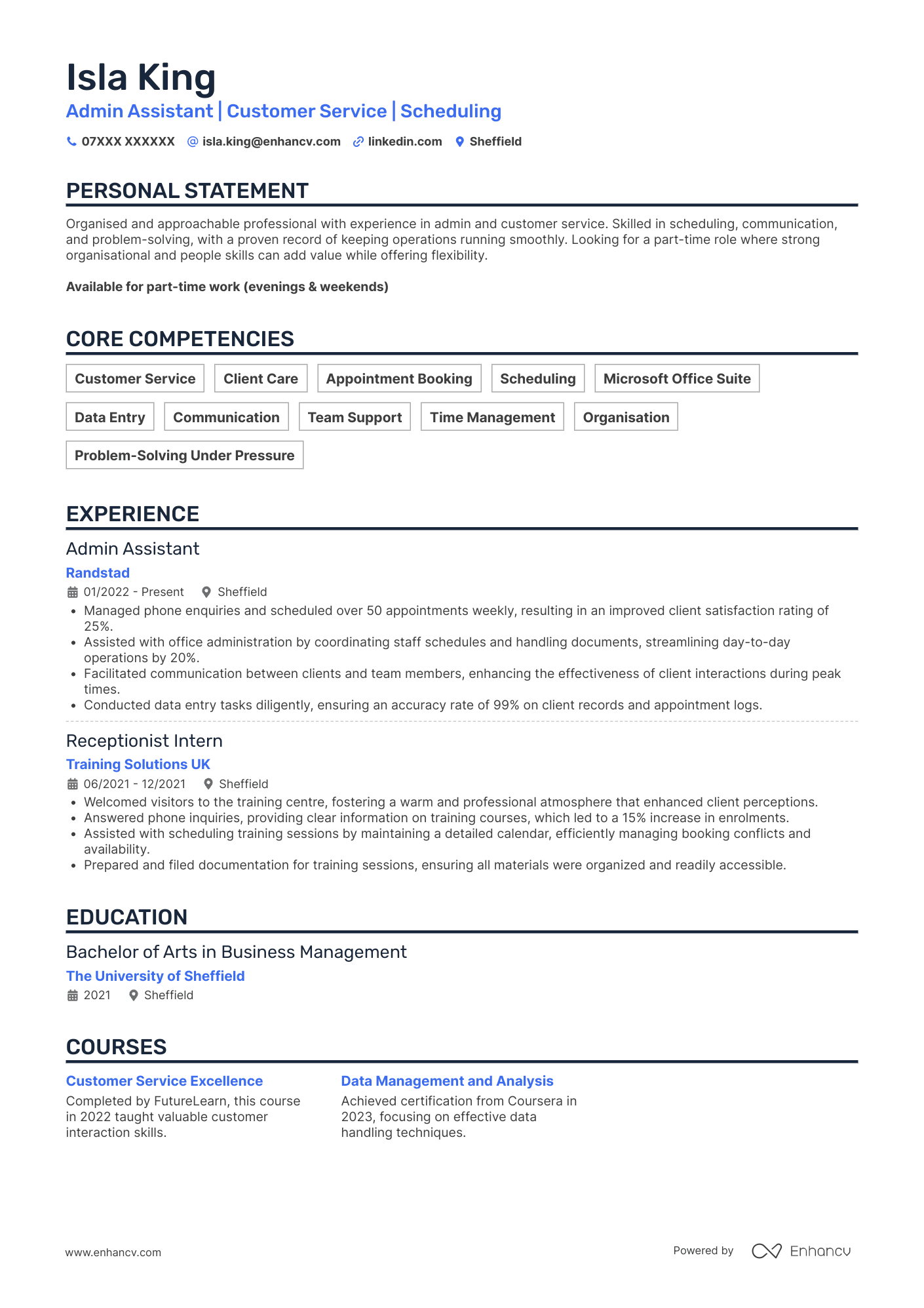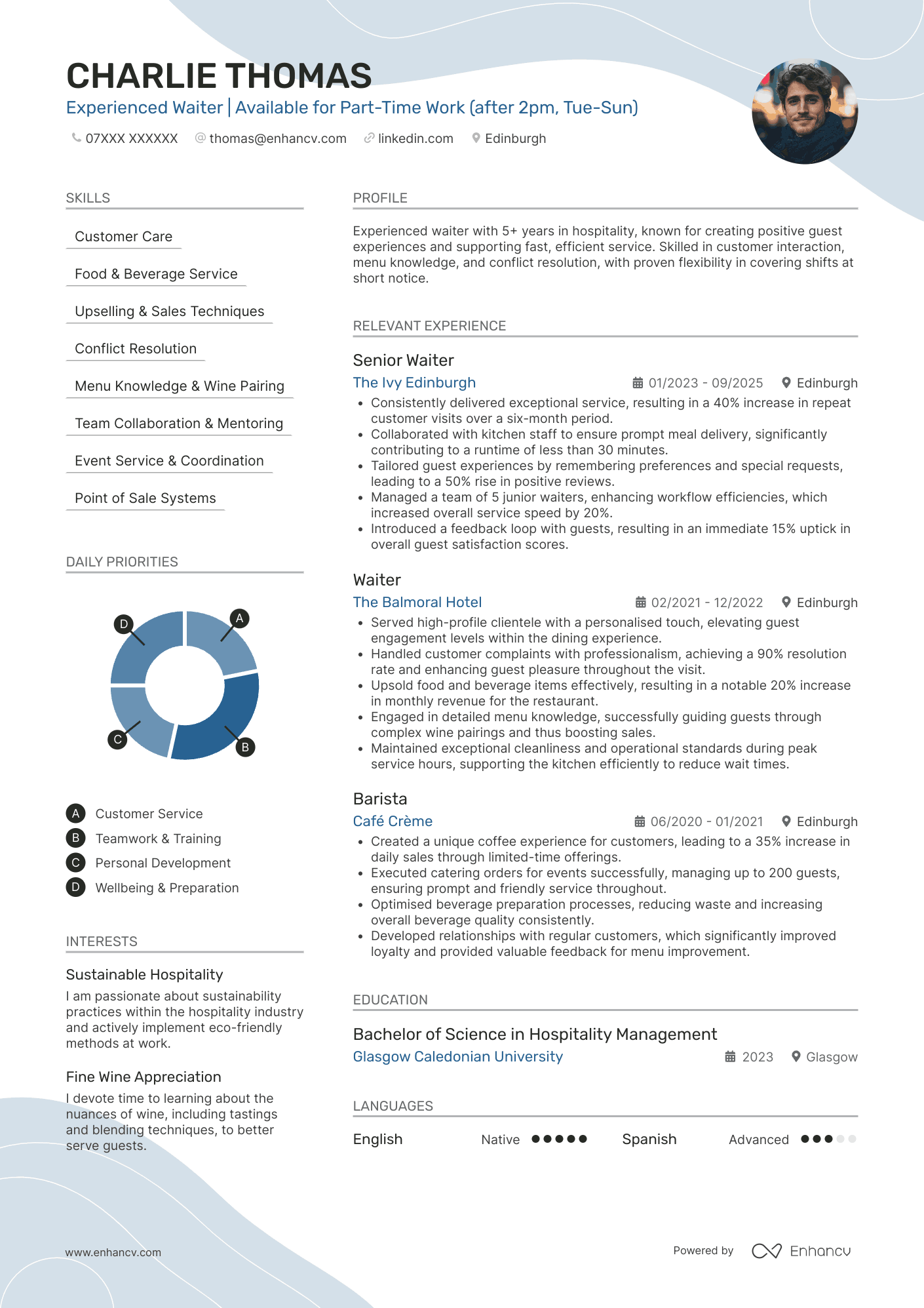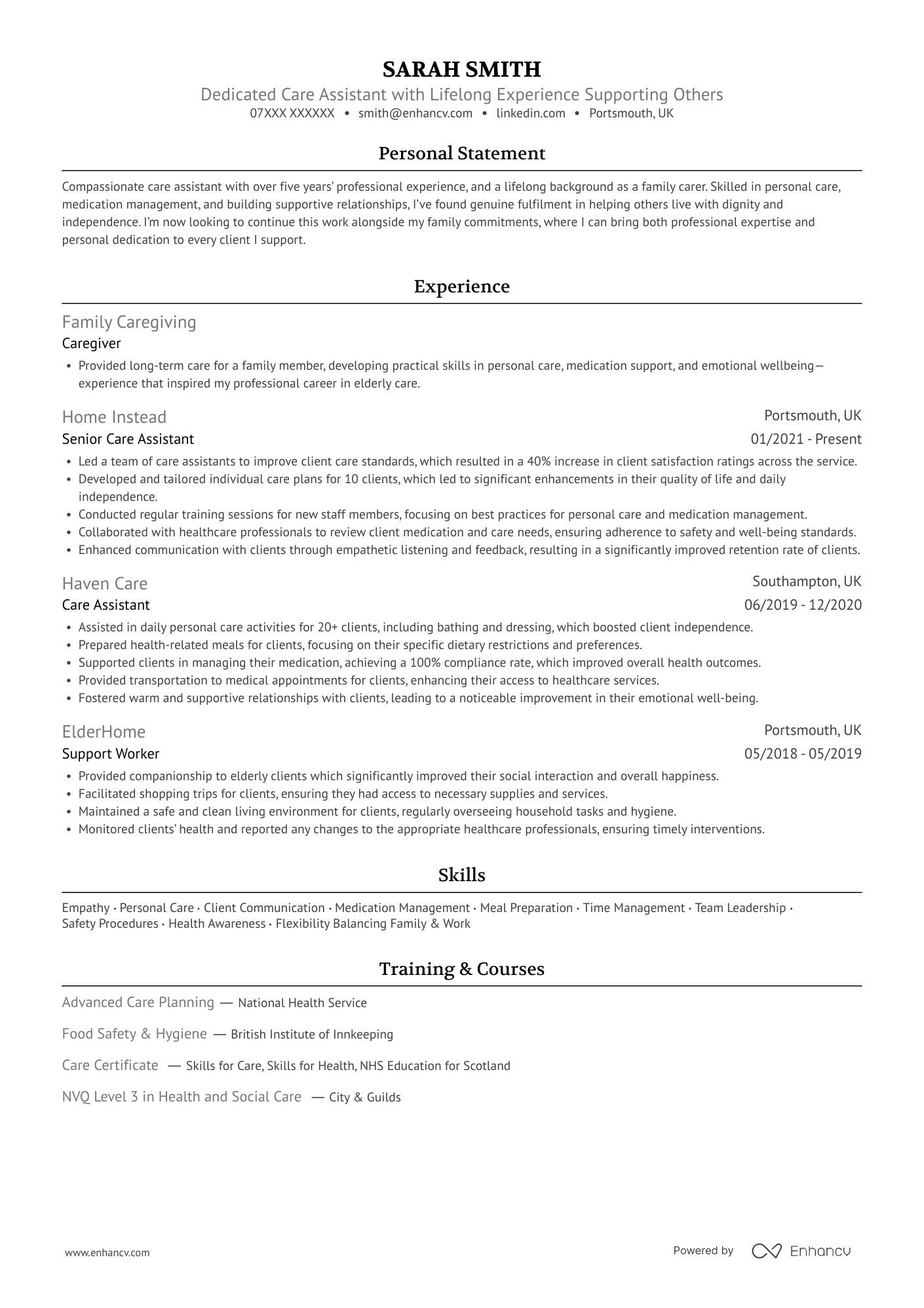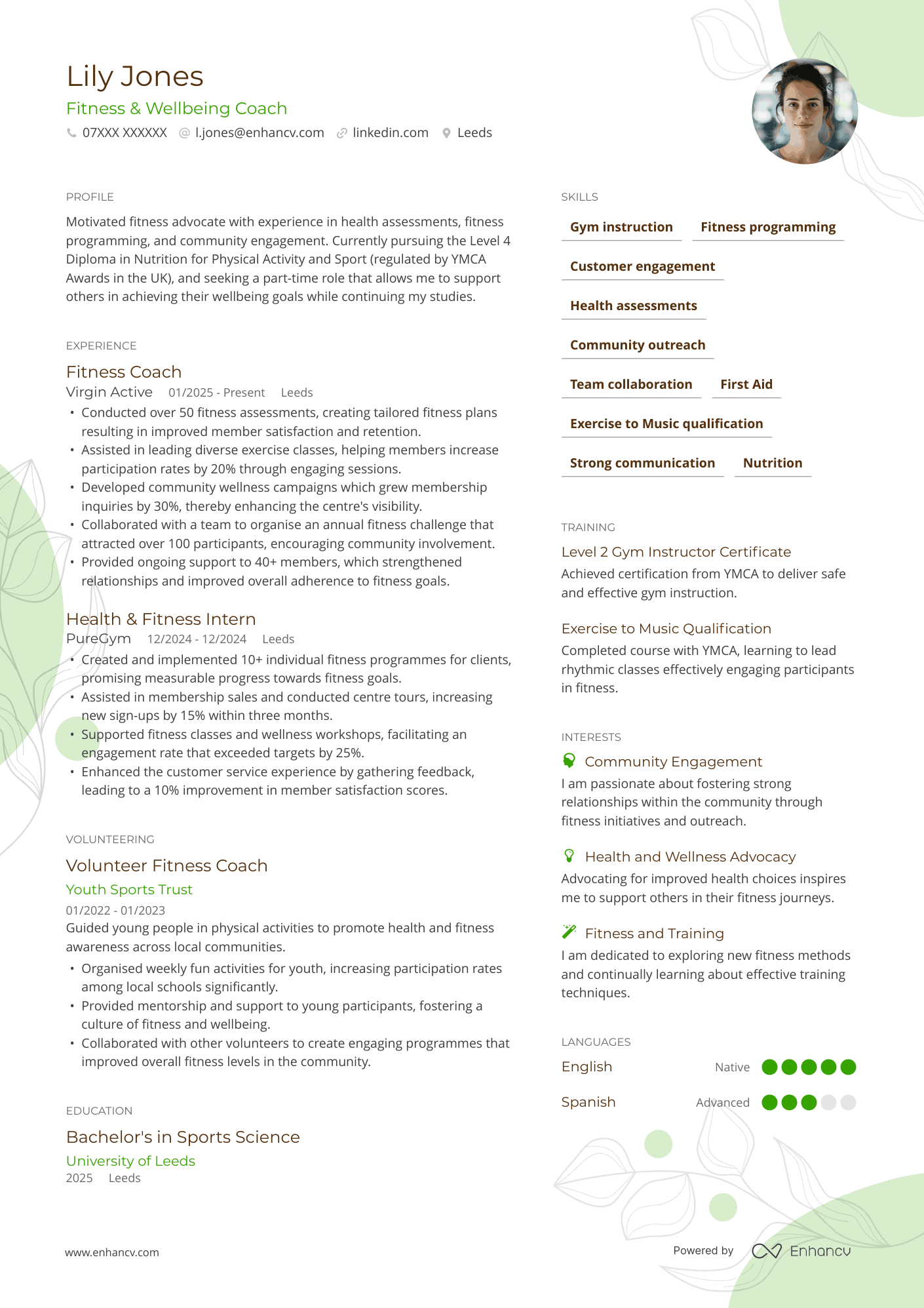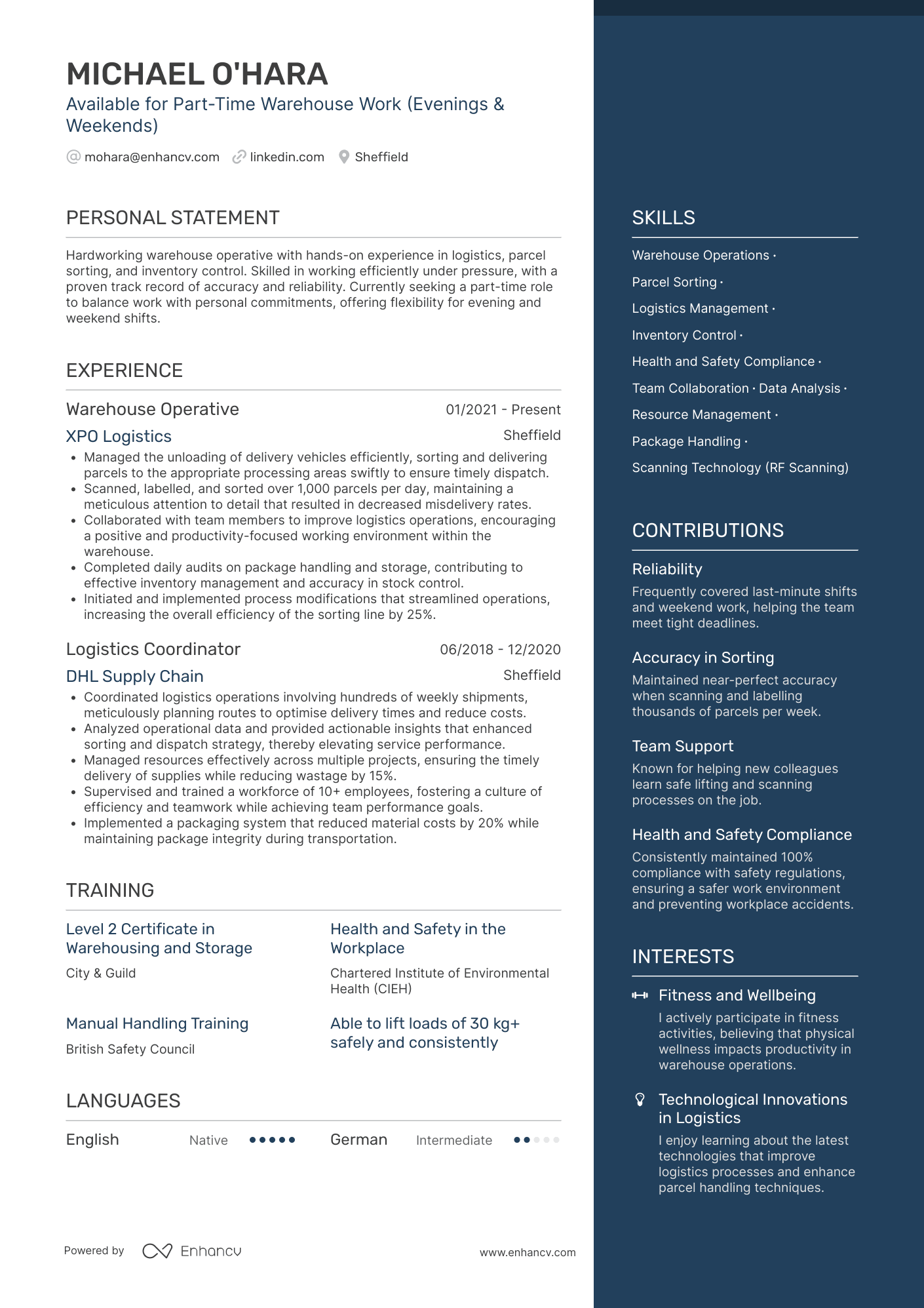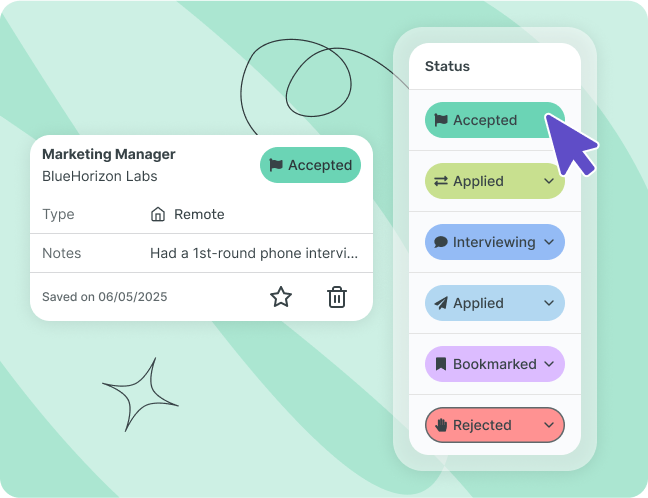There are approximately 8.6 million part-time employees in the United Kingdom. But how can you become one of them? Getting your foot in the door means learning how to write a CV for a part-time job. However, this is a task that all too many job-seekers find tricky.
Part-time workers can be everything from students and school leavers to non-traditional workers like carers, parents, or those wanting to boost their existing income. That means you may not have much formal experience or struggle to make extracurriculars sound professional.
Additionally, there’s the problem of availability, and making it clear which hours you can work. Plus, to instantly win over the hiring manager, you’re also going to want to tailor your CV to meet the needs of the job. Are you up for the challenge?
Luckily, you don’t need years of experience to nail your part-time CV. In the following guide, we’ll cover everything you need to know and share copyable example sections for you to use.

Key takeaways
- Be sure to make it clear you’re applying for part-time work rather than full-time.
- Fill any gaps in your work history by highlighting transferable skills and achievements.
- Tailor each CV to the role by matching keywords from the job description.
- Keep the format simple, concise, and UK-focused—aim for one page if you’re early in your career.
- Mention your availability, especially if you can cover evenings, weekends, or flexible shifts.
But wait, what if you’ve already written your part-time role CV? See how it measures up to other candidates by uploading it now.
Is your CV good enough?
Drop your CV here or choose a file. PDF & DOCX only. Max 2MB file size.
Let’s kick things off by explaining what a CV for a part-time job is.
What is a CV for a part-time job?
A CV for a part-time job is one you send out to hiring managers and employers when you’re looking for part-time roles. Like other CVs, this document needs to show off your skills, experience, and qualities that make you a perfect fit for the vacancy.
What counts as part-time work in the UK?
In Britain, full-time employees work at least 35 hours a week. If you’re applying for roles in which you’d work less than this benchmark, that will be classed as part-time hours.
When hiring part-time workers, employers will be looking for someone who is flexible, reliable, and has the ability to balance their time. Many candidates choose to take on part-time roles alongside other commitments, such as studying, caring for a loved one, or even another job or freelance work.

Your availability matters!
Hiring managers don’t merely want to know how many hours you’re available, they also want to know which hours. This is especially important if you’re applying for shift-based work.
For instance, if you’ve got weekend and evening availability, this could be a huge pro. Don’t be afraid to highlight this prominently either on your CV or your cover letter.
Your CV must convince the reader that you can give 100% to the role at hand, despite the fact that you won’t be working full-time hours. That can be a tricky sell. However, by highlighting your most high-value skills and showing how you align with the demands of the role, you should be on the right track.
Part-time CVs vs. full-time or graduate CVs
| Part-time CV | Full-time or graduate CV |
|---|---|
|
|
It takes a certain knack to write a good part-time role CV, and you don’t want to miss out anything vital. But before we get down to it, we’re going to talk about when you need a CV for a part-time job.
When do you need a CV for part-time roles?
Whenever you’re applying for a part-time role, you need to customise your CV accordingly. Of course, there are plenty of reasons that this working scenario may suit you.
Let’s break that down.

Types of part-time workers
- Students: If you’re at college or university, balancing a part-time role alongside your studies is a financially savvy move. You can supplement any loans or grants you have with this extra income.
- Career changers: Starting a new career? Rather than diving in the deep end, you may decide to begin on a part-time contract to get a feel for the industry.
- Work returners: As a parent or caregiver, it may not be viable to work full-time. However, you may be able to slot part-time work around your caring duties.
- Carers: When you’re caring for a loved one, that is a job in itself. Some people find that they can only work part-time hours during this time.
- Freelancers. Often enough, freelancers will supplement their income with a part-time job. This takes the pressure off landing new clients and provides a base income.
- Anyone boosting their income. This type of role is suitable for people in a range of situations and offers a level of flexibility not found with full-time jobs.
6 CV examples from popular part-time work industries
Any field in which shift work or casual contracts are common is sure to be a good place to start. With that in mind, let’s take a look at some of the areas you may want to research if you’re looking into part-time roles.
Retail
Shops need staff to cover busy periods, particularly evenings and weekends—plus the occasional holiday. It should come as no surprise that there are always plenty of part-time roles in this sector. We’re talking everything from shop assistants to floor managers.
While, in some cases, these may be full-time roles, they are often casual, shift-based positions, meaning that your hours could change on a weekly or monthly basis.
Here’s a part-time retail CV example tailored for a recent graduate. It highlights the candidate’s customer service experience while drawing attention to teamwork and reliability. The CV also makes clear their evening availability, which is an advantage for retail employers.
CV example for a part-time retail job
Admin and temp work
Similarly, offices tend to hire temp workers and part-time workers when things get busy. Roles can be everything from data entry and reception duties to filing and general office support. While you might find these advertised online, you can also look into temp agencies to place you on temporary contracts.
If you’re interested in casual or short-term roles, a recruitment agency is often the best first step.
Agencies can match you with temporary jobs in offices, retail, hospitality, healthcare, and more. Some of the most established temp agencies in the UK are:
We’ve put together an admin CV example suited to a part-time office support role. It highlights the candidate’s organisation and hard IT skills while pointing out their ability to manage tasks efficiently.
CV sample for a part-time office job
Hospitality
Whether you fancy working in a cafe, a bar, or your favourite eatery, hospitality is well-known for having a whole host of part-time jobs. Once again, these tend to be shift-based, which means that your hours will change on a regular basis. Since most hospitality venues are open late, you can often fit this type of work around another job or your studies.
Look at a hospitality CV example for a waiter role. This shows the candidate’s ability to work in fast-paced environments, emphasising customer service and multitasking skills. It also expertly underlines their flexibility to cover shifts at short notice.
CV example for a part-time waiter job
Healthcare support
Care homes, hospitals, and community settings often need part-time workers to offer valuable support. Since many of these roles tend to be shift-work-based, it means you can often get part-time hours that suit both your lifestyle and your circumstances.
In some cases, part-time roles in this sector can include an element of training, leading to more established healthcare careers.
CV for a part-time care assistant job
Tutoring and coaching
Since tutoring and coaching often takes place outside of normal working hours, there are many part-time jobs in this field. Very often, this involves working one-on-one with clients.
For example, if you’re working as an A-level tutor, you may meet with students to work on their homework. Similarly, if you are a fitness coach or a personal trainer, you may book hourly sessions with clients.
The example below shows how the profile section can highlight availability and part-time work aspirations.
CV sample for a part-time fitness coach job
Warehouse roles
The vast majority of warehouses operate around the clock. That means that they need flexible workers who are available for night shifts and far beyond the general nine-to-five working hours. Whether it’s picking and packing, loading and unloading deliveries, or organising stock, these roles tend to be highly varied. While the work can be physically demanding, it’s a stable industry to work in.
CV example for a part-time warehouse job
Now that you know when a part-time CV is needed, you’ve got two options: download one of the examples above and customise it in our AI-powered CV Builder, or create your CV from scratch.
In the next section, we’ll show you exactly how to do the latter.
How to write a CV for a part-time job (step-by-step)
Writing a CV for a part-time job takes a certain finesse. Your aim is to position yourself so that employers see your value. Even if you don’t have much work experience, you can use this document to show off your potential.
Use the steps we’ve provided below to get started.
Step 1: Choose the right CV format
First up, you’ll need to choose which CV format suits you and your circumstances. The three main types to consider are the reverse-chronological format, the skills-based format, and the combination format.
You need a CV format that shines a light on your value. For students and school leavers, a skills-based CV works best as it highlights competencies gained through education and extracurriculars. For job seekers with prior experience, the combination format is stronger since it balances your work history with your skills.
When you’ve decided which structure works the best, move onto the next step.
Step 2: Add your contact details
Next up, it’s time to add your contact details to your CV header. That means your full name, a phone number, an email, and your location. You can add extras including your LinkedIn profile or professional website or portfolio. Make sure this is easy to read and spaced correctly.
You don’t need to include any personal information, such as your full address, or date of birth. In most cases, a photo isn’t expected—but for some customer-facing roles (like hospitality or retail), an employer may request one, so always check the job description first. Additionally, you really don’t need to add the word “curriculum vitae” to your CV. The hiring manager should already know what they’re looking at, and this appears extremely outdated.

PRO TIP
Use the headline to highlight your availability!
If you have niche availability—such as evenings and weekends—now’s the time to say so. You can display this prominently in your CV headline so it’s the first thing the hiring manager sees.
Here’s an example:
Sarah Johnson
Available for Tutoring (Evenings & Weekends)
Manchester, UK
Tel: 07123 456 7XX
Email: sarah.johnson@email.com
LinkedIn: linkedin.com/in/fullname
When you’ve nailed the header, you can move onto your personal statement.
Step 3: Write a short personal statement
This is your chance to make a killer first impression. Your personal statement should be short and sweet. It’s just two to four sentences that introduce who you are, what you bring, and what you’re looking for.
You can either write a CV objective or a CV summary, depending on your work experience level. If you’re new to the working world, use an objective to tell the hiring manager what you plan to do in your career. If, on the other hand, you have a bunch of experience, a summary shares your highlights.
CV objective vs. CV summary
| CV objective | CV summary |
|---|---|
|
|
Here’s an example of a CV objective for a part-time worker:
Compassionate and dependable individual looking for a part-time role as a care assistant in a residential home. Brings volunteering experience in a community centre, strong communication skills, and a genuine interest in supporting the wellbeing of others.
And, this is how a CV summary might look for a part-time CV:
Reliable and adaptable worker with over two years of experience in retail and customer service. Consistently recognised for efficiency, having processed an average of 150+ transactions per shift with 98% accuracy. Demonstrated strong teamwork by supporting a store team that exceeded monthly sales targets by up to 12%.
When you’ve mastered this step, you’ll need to show off your work experience.
Step 4: Highlight your work experience
If you have no work experience and you’re using a functional CV, you can skip this step. However, if you’re working on a combination or reverse-chronological CV, you’ll want to perfect this part of the process.
Paid, unpaid, volunteering, and extracurricular roles all count towards your work experience. Start by listing the basic details: the company name, location, your role, and how long you were employed. Below that, you can list bullet points that cover your achievements with numbers or statistics.
Check out an example below:
Work Experience
Sales Assistant (Part-Time)
Tesco Express, Manchester
June 2022 – Present
- Assisted an average of 80–100 customers per shift, ensuring friendly service and quick resolution of queries.
- Handled cash and card payments at the till with 100% accuracy, balancing up to £3,000 per shift.
- Restocked shelves and maintained product displays, helping the store meet merchandising standards during weekly audits.
Volunteer Shop Assistant
British Heart Foundation, Manchester
January 2021 – May 2022
- Processed donations, sorted stock, and maintained a clean and organised shop floor.
- Provided customer assistance, contributing to a 20% increase in sales during peak periods.
- Operated the till and handled cash, gaining early retail and customer service experience.
When applying for part-time jobs, you want to stress your reliability and teamwork skills. To do that, focus on your track record, any time you collaborated with others, and your years of service in your work experience section. Customise your CV to shine a light on these points above other attributes.

PRO TIP
Be specific in this section!
There’s no room for vague statements when writing your work experience section. Employers want to know what you actually did and the scale of your responsibilities.
Be clear so the reader understands exactly what level of experience you have. For example, rather than writing “Helped with customers,” you could say “Served an average of 60 customers per shift, answering questions and resolving issues to maintain high satisfaction levels.
Finally, add some action verbs into the mix to elevate your experience. These show that you were the driving force behind each of your achievements.
Once you’re pleased with your work experience section, crack on with your education or qualifications.
Step 5: Include your education
This section may be short, but it plays a vital role in helping you land a part-time job. It’s particularly important for first-job seekers and students. List your GCSEs, A-levels, and degrees. Make sure that they are clear and add your grades so long as they are above average.
Take a look at our example section below:
Education
Manchester College
BTEC Level 3 Diploma in Business (Predicted Merit)
September 2022 – Present
- Studying business management, finance, and marketing modules.
- Group project achieved a distinction grade for creating a business plan for a start-up café.
St Peter’s High School, Manchester
GCSEs, June 2022
9 GCSEs, grades 9–5, including:
- English Language (7)
- Maths (6)
- Combined Science (6, 6)
If you’re still studying, you can put either ‘Present’ or ‘Ongoing’ on the associated qualification. You may also want to share your predicted results, as this gives the reader an idea of what you may achieve.
Next, share your most in-demand skills with the reader.
Step 6: Showcase your skills
Having the right skills on your part-time CV can make all the difference. To show you’re a well-rounded candidate, you’ll need a mixture of both hard skills and soft skills for this section.
Core transferable—also known as soft—skills employers want in part-time hires include communication, organisation, teamwork, reliability, and flexibility.
The hard skills you list will depend on the sector. For example, if you’re working in retail, you may list stocktaking and POS systems.
Here’s an example skills section for a part-time retail worker:
Skills
- Customer service
- Cash handling
- Teamwork
- Time management
- Stock management
- POS systems
While you should focus on popular skills for part-time workers, you can dig deeper. Matching your skills to the core criteria in the job advert will boost your chances of success. That way, you increase your odds of getting past the applicant tracking system (ATS) while impressing the hiring manager with your suitability.
Step 7: Add optional sections
By this point, you should have a pretty robust part-time CV. But can you add even more value?
Here are some optional extra sections you can include, should they bring something new to the table:
Volunteering section
This section is similar to your work experience section, but contains only volunteering positions. You should list the name of the charity or organisation, your role, and your dates of involvement. Next, you can craft some choice bullet points that detail the achievements you gained.
Here’s how that may look:
Volunteering
Volunteer Shop Assistant
British Heart Foundation, Manchester
January 2022 – Present
- Supported customers on the shop floor and at the till.
- Sorted donations and prepared stock for display.
- Helped raise an average of £500 per week through sales and gift aid.
Event Steward (Volunteer)
Manchester Half Marathon, Manchester
October 2021
- Directed participants and spectators to ensure safety and smooth event flow.
- Worked as part of a team of 20 volunteers to assist over 10,000 runners.
Certificates or short courses
If you’ve got a wealth of job-related certificates and short courses under your belt, you may want to list them in a dedicated section. Your certification section can be separate to your education section, especially if the learning took place outside of a classroom.
Take a look at our example for inspiration:
Certifications
- Food Safety Level 2 – Highfield, 2023
- Emergency First Aid at Work – St John Ambulance, 2022
- Health and Safety in the Workplace Level 2 – British Safety Council, 2022
- Customer Service Excellence Workshop – Tesco Training, 2021
Hobbies and interests
If you lack formal work experience, it may be worth sliding in a hobbies and interests section. However, make sure that each one shows either responsibility or initiative. Examples could include taking on the role of sports captain, fundraising for a charity, or working with children and young people.
Here’s an example of a Hobbies and Interests section for a Maths tutor. It shows personality while also reinforcing skills like problem-solving, mentoring, and leadership that are valuable in tutoring.
Hobbies and Interests
- Youth mentoring
- Music performance
- Math clubs and competitions
- Puzzle solving and strategy games
It’s not about simply adding sections for the sake of it. Each optional section you include must serve a real purpose. Before you add one, ask yourself “Does this truly improve my application?”
You’ve conquered the content, the next step is to make sure your CV looks the part.
Step 8: Keep formatting simple and professional
Your CV doesn’t need flashy designs or graphics to stand out from the crowd. Stick to an A4 layout, choose a clear font, use bullet points instead of long paragraphs, and leave plenty of white space so the content is easy on the eye.
When you're applying for part-time roles, aim to keep your CV to a single page. This means everything you write is relevant, while still giving employers a clear picture of your skills and experience.
If you follow these steps exactly, you should have no problem crafting a stellar part-time CV.

How to tailor CV for each part-time job
- Match the language. Emulate the language of the job description. This helps you pass the ATS system and shows the employer you pay attention to what they need.
- Pick out your top skills. Swapping the skills you highlight so they reflect the job advert makes your CV feel tailored rather than generic.
- Think about the industry. A retail CV should emphasise customer service and cash handling while a hospitality one focuses on teamwork and flexibility. Consider the industry and think about what the hiring manager is likely to look out for.
- Track and tailor your applications: Keep a version of your CV for each role you apply to, adjusting the skills and experience to match the job description. With Enhancv’s job tracker functionality, you can easily create and manage multiple CVs—each customised to fit a specific opportunity.
Now that you know exactly how to write a part-time CV, we can share some examples.

Mistakes to avoid when writing part-time CVs
- Being too generic. Hiring managers want to see evidence. Back up any claims with real examples to show how you’ve contributed in past roles.
- Including irrelevant details. Listing every club you’ve joined or modules you’ve studied distracts from the key information. Focus on what supports your application.
- Using US-style conventions. If you’re in the US and applying to work in the UK, choose your words with care. British employers expect GCSEs and A-levels (or equivalents), not GPAs or SAT scores. Sticking to British terminology avoids confusion.
- Forgetting to proofread. Spelling or grammar mistakes make you look careless. Always check your CV carefully and reread it before sending.
Avoiding these mistakes will help you avoid any problems later down the line. After all, you don’t want to fall at the final hurdle.
Frequently asked questions about part-time CVs
Have we missed something along the way? Check out our frequently asked questions now:
How long should a part-time CV be?
One page is usually enough for part-time CVs. The hiring manager wants to see the essentials quickly, so keep it concise and focused.
Do I need a cover letter?
Most of the time the answer is yes. Writing a cover letter allows you to introduce yourself to the hiring manager and explain why you’re a good fit for the role.
Can I include school or college projects as experience?
Yes, especially if you don’t have much formal work history. These projects are a great way to show skills like teamwork, organisation, or problem-solving.
Should I mention my availability on my CV?
Yes, you should. If you can work evenings, weekends, or other flexible hours, say so. That’s going to be a huge bonus and could work in your favour if the manager has tricky shifts to fill.
Key takeaways
A part-time CV should focus on relevance rather than just length. The quickest way to land interviews is to tailor each new CV to the job description, highlighting what the employer is looking for. Keep the format simple, professional, and aligned with British norms, and you’ll give yourself the best chance of success. Why not use our drag-and-drop CV maker tool to get started now?

